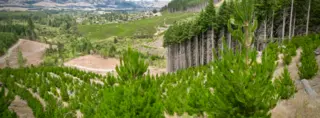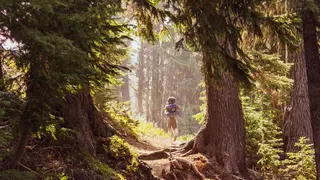

When you hear the term “clear-cutting,” you probably think of a forest, eradicated. But when you learn the facts about clear-cutting, you’ll see it differently: a method of responsible forestry management that clears the land for more.
More trees, more forests, more biodiverse environments.
More of the land we love—and as evidence, look at the amount of net forestland in the U.S. between 1990 and 2020, which increased by 18 million acres, according to the United Nations Food and Agriculture Organization. That’s an area greater than the square footage of South Carolina. The increase is largely thanks to responsible forest management, supported by the paper industry. Here’s what to know about clear-cutting today.
What Is Clear-Cutting? What’s the Difference Between Clear-Cutting and Deforestation?
Clear-cutting happens when most or all of the trees in a defined area are strategically removed with the intent of reforesting that area, either through replanting or, more often, by encouraging natural regeneration of the “parent” trees via sprouting from the root systems or cut trunks.
Most clear-cutting is purpose-driven, with reforestation built into the plan. In many ways, it intentionally mimics the natural process of wildfires (distinct from destructive wildfires) and other natural disturbances that clear the land, which in turn initiates, supports and promotes new growth and regeneration by providing sunlight to the forest floor.
Human-caused deforestation is when forests are often permanently destroyed, usually with the goal of converting that land to nonforest purposes such as agriculture and urban development. The intent isn’t to protect forests; it’s to end them. Globally, deforestation is declining, but tropical forests still widely suffer from the practice, particularly in the Amazon.
Industries that rely on healthy forests, such as the paper industry, fight deforestation because keeping forests as forests is critical to their operations—after all, the raw material needed for products is derived from forests. Foresters often use responsible clear-cutting as a sustainable forest management practice to regrow and perpetuate healthy forests with vibrant, resilient trees that support wildlife habitat and biodiversity.

What Reasons Are There for Clear-Cutting?
Because it mimics natural processes that ultimately nourish the land, clear-cutting is a way of returning forests to a state of equilibrium. It fosters wildlife habitats that need young forests to thrive. Mature forests have many benefits to the ecosystem, but young forests are unique shrubland habitats that encourage the growth of seedlings and saplings and that house a variety of animal life. Without clear-cutting, the broad canopy of mature forests prevents new growth, and young forests never have a chance to take root. Plus, per acre, older-growth forests sequester less carbon than younger, growing trees.
Whether trees are removed to encourage new growth, manage invasive species, handle pest or pathogen outbreaks, or responsibly harvest timber for the paper industry and other forest products, removing most or all trees at once results in less disturbance to the land and surrounding areas, according to organizations such as the Oregon Forest Resources Institute. Additionally, clear-cutting is a cost-effective management tool that provides an important revenue source for landowners from which to pay the land taxes and reinvest in their forests.
What Are the Pros and Cons of Clear-Cutting?

What Does the Forest Recovery Process Look Like for Clear-Cutting?
After a specified area has been cleared, the type of flora that needs more hours of sunlight to thrive begins to take root or is spurred into growth, leveraging the resources stored in existing root systems. Quickly—within only a few years—shrubs, grasses and saplings sprout, whether naturally regenerated or planted, flourishing without as much competition from the taller trees. A variety of wildlife uses clear-cuts for nesting, foraging and cover. In the years after a clear-cutting, a diverse ecosystem takes hold, creating a vibrant natural community that contributes to clearer air, cleaner water and lush habitats.
How Can I Support Forest Health?
When you choose paper-based products in your day-to-day life, you’re contributing to responsible forest management. Because the raw materials for paper come from mostly privately owned forests that are sustainably managed and harvested, the paper industry has an investment in protecting and regenerating forests. So when you buy paper products, you’re protecting the land from being converted by the landowner to other uses or sold to other industries that could permanently convert it to nonforest uses, such as urban development and agriculture.
If you want to keep doing your part, it’s time to become a papertarian. Here’s what that looks like:

- Opt for food and beverages packaged in paper or cardboard.
- Use paper-based products for your everyday life—toilet paper, paper towels, etc.
- Seek out toiletries packaged in paper—think bar soap and tube deodorants.
- Recycle paper-based and cardboard packaging.
- Sign the papertarian pledge to join the movement.



